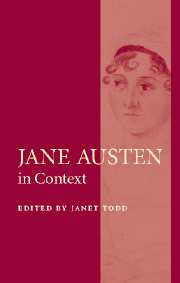25 - Landscape
Published online by Cambridge University Press: 19 December 2020
Summary
In the decade in which Jane Austen was born, the English landscape garden was at the peak of its renown, and the picturesque vogue was in its early stages. The spacious park landscapes of Lancelot ‘Capability’ Brown (1715–83) at such places as Blenheim, Chatsworth and Harewood displayed the taste of landed gentlemen who resided on their estates. The mountains of Wales, the Lake District and the Scottish Highlands catered to a different group: prosperous but unlanded tourists mostly, women as well as men. Equipped with guidebooks, sketchbooks, maps, pedometers and Claude glasses, enthusiasts for the picturesque sought out wild scenery, preferred ruined abbeys to Doric temples and valued a native Gothic past over the classical heritage admired by those who took the European Grand Tour.
Both tastes in landscape had their champions. Horace Walpole, in his History of the Modern Taste in Gardening (printed 1771, published 1780), promoted the Whig view that the natural style of the English garden was an expression of liberty, whereas the geometric formality of the French garden signified political despotism. In the landscapes of William Kent (1684–1748), he found ‘the delicious contrast of hill and valley’, ‘the beauty of the gentle swell, or concave scoop’. Such descriptions might equally refer to Brown's landscapes, with their rolling lawns, grouped trees, serpentine lakes and encircling belts of woodland, and they accord with Edmund Burke's definitions of the beautiful in his Inquiry into … Our Ideas of the Sublime and Beautiful (1756). Walpole had praised Brown in passing, but it was left to Thomas Whately, in his Observations on Modern Gardening (1770), to provide the rationale for Brown's system. Whately criticised the devices, ‘rather emblematical than expressive’, used in earlier gardens such as Stowe and The Leasowes. Elevating gardening to a liberal art, he analysed natural materials (ground, wood, water, rocks, buildings) and encouraged designers to express the ‘original’ character of a place (Observations, 3rd edn, pp. 151, 153).
As for the picturesque, the vogue was already being promoted as William Gilpin (1724–1804) was taking his tours to various parts of Britain in the 1770s, and before he began to publish his Observations, beginning in 1782.
- Type
- Chapter
- Information
- Jane Austen in Context , pp. 278 - 288Publisher: Cambridge University PressPrint publication year: 2005
- 1
- Cited by



